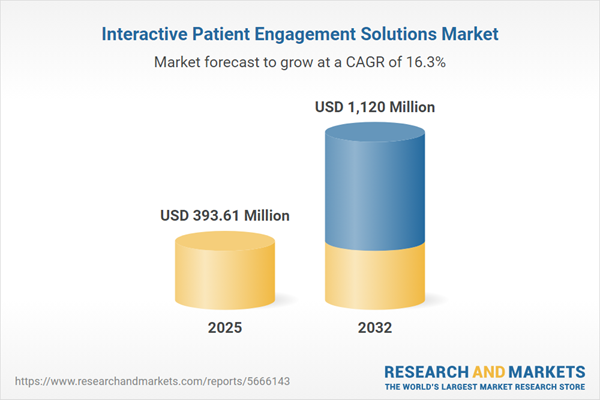Speak directly to the analyst to clarify any post sales queries you may have.
The Interactive Patient Engagement Solutions Market is driving digital transformation in healthcare, enabling better coordination and streamlined communications across care teams. Senior leaders are prioritizing technology investments that integrate with strategic objectives and support dynamic patient requirements.
Market Snapshot: Interactive Patient Engagement Solutions Market
The Interactive Patient Engagement Solutions Market continues a steady upward trajectory as healthcare embraces value-based care. Organizations now adopt secure digital platforms and analytics to personalize patient engagement, simplify care delivery, and meet evolving regulatory standards. Changes in industry policy drive demand for agile, interoperable technologies that enable fast adaptation and sustained compliance. Early adopters differentiate themselves by leveraging these solutions for improved patient experience and elevated positions in digital healthcare. The market’s momentum reflects an industry-wide push toward better digital healthcare delivery and operational excellence.
Scope & Segmentation of the Interactive Patient Engagement Solutions Market
Targeted segmentation in this market empowers healthcare providers to match technology investments to organizational and clinical priorities, exploiting advanced tools to maximize operational impact and patient value.
- Component: Interactive kiosks and wearable devices streamline patient check-in and provide continuous health data. Software systems facilitate communication, data analytics, and reporting, while services address implementation, staff development, and ongoing support.
- Application: Solutions address appointment scheduling, telehealth integration, medication adherence, patient education, and remote monitoring, creating diverse avenues for patient engagement and individualized care management.
- Delivery Channel: Platforms include on-premise kiosks, secure web interfaces, and mobile applications, offering multiple modalities for patients to connect with providers in varied care environments.
- Deployment Mode: Deployment options span cloud, on-premise, and hybrid models, accommodating a range of privacy, infrastructure, and operational requirements for different organizations.
- End User: Hospitals, outpatient clinics, ambulatory care entities, and home health agencies employ these platforms to foster collaboration among care teams and enhance clinician-patient communication.
- Region: Distinct regional priorities emerge, with North America leading on integration and compliance, Europe emphasizing interoperability and governance, and Asia-Pacific and the Middle East & Africa advancing solutions in line with infrastructure growth and regulatory evolution.
- Companies Analyzed: Epic Systems Corporation, Oracle Corporation, Veradigm Inc., GetWellNetwork Inc., Medical Information Technology Inc., Koninklijke Philips N.V., Vocera Communications Inc., eVideon Inc., Lincata Inc., and PatientPoint LLC are key drivers extending innovation and industry influence.
Key Takeaways for Senior Decision-Makers
- Integrated engagement technology enables collaboration and efficient workflows from admission to post-discharge, supporting multidisciplinary care coordination across the organization.
- Advanced analytics platforms drive actionable insights, guide the targeted development of patient outreach, and help optimize allocation of resources at the system level.
- Comprehensive digital care integration, including telehealth and remote monitoring, supports broader patient access and streamlines compliance across regulatory environments.
- Investments in scalable and interoperable IT infrastructure position organizations to adapt to regulatory shifts while reinforcing privacy and security best practices.
- Strategic alliances, such as mergers or partnerships, enhance solution portfolios and improve flexibility in responding to new care models and delivery demands.
- Regular evaluation of digital engagement initiatives ensures ongoing alignment with evolving patient needs and helps organizations stay responsive to operational demands.
Tariff Impact: Anticipating U.S. Policy Adjustments in 2025
Upcoming tariff shifts in the U.S. are expected to influence hardware pricing for interactive patient engagement equipment, particularly kiosks and wearable devices. Senior healthcare executives should evaluate supplier networks, review sourcing strategies, and monitor trade policy developments closely. For organizations reliant on cross-border supply chains or significant hardware procurement, proactive contingency planning is recommended to address possible cost and availability risks.
Methodology & Data Sources
The analysis leverages quantitative market forecasts, senior executive interviews, and direct insights from healthcare end users. Each segment and trend has been validated by industry professionals, ensuring that the findings respond directly to present-day B2B priorities in healthcare.
Why This Report Matters
- Equips executive leaders with market-driven insights to evaluate and deploy digital patient engagement platforms aligned with evolving health system objectives.
- Enables healthcare organizations to maintain business resilience and adaptability amid ongoing regulatory or market transitions.
- Delivers expert-validated analysis for informed vendor selection, IT infrastructure planning, and compliance strategy development across the enterprise.
Conclusion
This report provides healthcare executives with clear direction for shaping digital engagement strategies, supporting improvements in patient experience, operational performance, and long-term competitiveness in a rapidly evolving industry.
Additional Product Information:
- Purchase of this report includes 1 year online access with quarterly updates.
- This report can be updated on request. Please contact our Customer Experience team using the Ask a Question widget on our website.
Table of Contents
3. Executive Summary
4. Market Overview
7. Cumulative Impact of Artificial Intelligence 2025
Companies Mentioned
The companies profiled in this Interactive Patient Engagement Solutions market report include:- Epic Systems Corporation
- Oracle Corporation
- Veradigm Inc.
- Medical Information Technology, Inc.
- GetWellNetwork Inc.
- Koninklijke Philips N.V.
- Vocera Communications, Inc.
- eVideon Inc.
- Lincata, Inc.
- PatientPoint, LLC
Table Information
| Report Attribute | Details |
|---|---|
| No. of Pages | 188 |
| Published | November 2025 |
| Forecast Period | 2025 - 2032 |
| Estimated Market Value ( USD | $ 393.61 Million |
| Forecasted Market Value ( USD | $ 1120 Million |
| Compound Annual Growth Rate | 16.2% |
| Regions Covered | Global |
| No. of Companies Mentioned | 11 |









